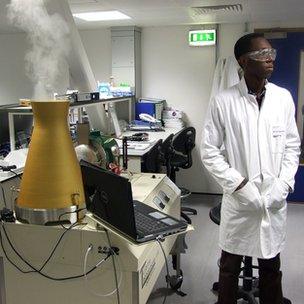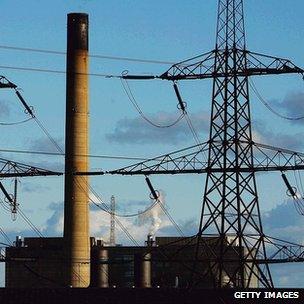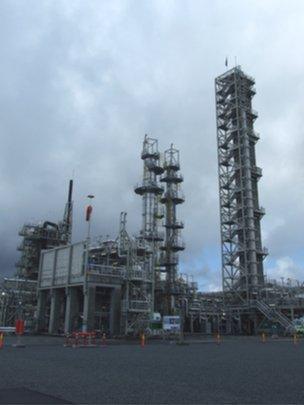Whatever happened to carbon capture?
- Published

University students can now study CCS; but when will it come fully out of the lab?
The process was patented back in the 1930s, and it is reckoned to be one of the most important technologies we have for tackling greenhouse gas emissions.
So you might well ask: "Whatever happened to carbon capture and storage (CCS)?"
The International Energy Agency (IEA) forecasts global energy demand increasing by at least one-third by 2035.
The majority of that increase will come from burning fossil fuels; and without capturing and storing some of the carbon dioxide (CO2) emissions that result, this implies a significant addition to global warming.
To meet the internationally agreed target of keeping the temperature rise since pre-industrial times below 2C (3.6F), the IEA calculates there should be about 1,500 full-scale CCS plants in operation by 2035.
Currently, there are just eight.
"I think we're a bit behind where we need to be," says Brad Page, CEO of the Global Carbon Capture and Storage Institute, with laconic Antipodean understatement.
"And that means we're going to need governments to step up and get supportive policies in place for clean energy generally and also for CCS."
Underpriced
I am speaking to Mr Page at a seminar in Bergen, Norway, attended by luminaries of the nascent industry who came <link> <caption>to see the world's largest CCS research facility inaugurated at Mongstad</caption> <url href="http://www.bbc.co.uk/news/science-environment-18009623" platform="highweb"/> </link> just along the coast.
A theme running through many of their presentations is that political support for countering climate change has fallen since the UN climate summit in Copenhagen in 2009.
In Europe, the main mechanism designed to spur low-carbon generation is the Emission Trading Scheme (ETS) and the price that puts on emitting carbon dioxide.
"That's very important, because if everyone is walking around thinking that emissions are cost-free, there's no initiative for doing anything about it," says Ola Borten Moe, Norway's Minister of Petroleum and Energy.

Ola Borten Moe: carbon pricing "essential"
"So I think it's crucial that not only in Europe but elsewhere that companies get a clear signal from the market."
CCS makes electricity more expensive. Extra fuel needs to be burned to drive the process of capturing CO2 from the power station's flue gas, and to pump it down to its resting place in rock deep underground.
If the carbon price were high, companies would find it cheaper to run coal- and gas-fired power stations with CCS fitted than to pay for the CO2 emitted from conventional plants.
However, the European carbon price is now so low - about 7 euros ($9) per tonne - that the only signal it sends is "carry on emitting".
The price has fallen because of the recession and because European governments have lobbied against tightening caps on emissions. Tough caps deliver a high carbon price.
Australia's new carbon price will come in at $23 per tonne, and is likely to fall further - also too low to spur businesses to invest in CCS.
So as things stand, there is no sign that carbon pricing is going to drive an expansion in CCS.

The dominant technology is still the oldest - absorption of carbon dioxide by liquid amines
If the carbon price was the only driver of change, most renewables would founder as well - as would nuclear, in all probability.
But in Europe and elsewhere, many governments support renewable energy with substantial subsidies, delivered in a number of forms.
As a result, installation of wind power grew across the world by 27% per year over the period 2005-10, and solar photovoltaic by an astonishing 56% annually.
But governments are not supporting CCS in the same way.

UK interest is now falling again on the "Goldeneye" CCS opportunity at Peterhead power station
There is an irony here, because successive reports by international and national agencies suggest that electricity from coal- or gas-fired power stations fitted with CCS is probably going to be cheaper than offshore wind farms and solar panels - and in some cases, depending on assumptions about fuel prices, as cheap as onshore wind.
"You're looking at a 70-100% increase in the production cost of electricity from fitting CCS; but in terms of the cost of electricity delivered [to the customer] it goes up by say 30%," says Howard Herzog from Massachusetts Institute of Technology, who has been researching the technology for more than a decade.
"Renewables probably get the most support from government in terms of production subsidies; if CCS got some of the same subsidies, I think you'd see a lot more projects."
Instead, government support for CCS tends to come in the form of one-off grants for construction.
The biggest was the $3bn pledged by President Barack Obama as part of the US economic stimulus package. But China, South Korea, Japan, Canada and the UK are also in various stages of investment.
A recent report from the UK Energy Research Council showed that the UK especially has abundant potential for storing CO2 under the seabed - potentially building a new business taking waste gas from more landlocked parts of Europe.
However, the falling carbon price has drastically curtailed European Commission plans to fund up to 12 projects across the continent. It is now likely to support just a handful.
Revenue raising
Against this backdrop, you might ask why there are as many as eight large-scale CCS projects in the world.

Mongstad becomes the world's largest test centre for carbon capture technologies
The answers are that none are fitted on power stations, and that they all make money in other ways.
The oldest project is the Sleipner gas field off the Norwegian coast.
Norway's carbon tax means it is cheaper for the company involved, Statoil, to extract and bury the CO2 contained in the natural gas than vent it to the atmosphere.
Five of the other facilities pump the CO2 down into oil wells, increasing the pressure and enabling the operators to recover more oil - a benefit so significant that they are prepared to pay about $40 per tonne.
Five of the seven plants under construction will also use the captured CO2 for enhanced oil recovery (EOR).
"If we can get the technology accelerated by EOR, that's wonderful," Bjorn-Erik Haugan, CEO of the Norwegian state CCS agency Gassnova, told delegates at the seminar.
"But we should not mistake this for combating climate change."
Planting a dream
While governments wrestle with financial questions, engineers from academia and the corporate sector are exploring various ideas for making CCS more efficient and thus cheaper.
Most attention centres on the capture part of the process, which is the most energy-intensive.
In part, the idea is to refine the approach first recognised in the 1930s, which exploits the chemical affinity between carbon dioxide and nitrogen-based molecules such as ammonia or the closely-related amines.
But other capture technologies based on fine membranes are also in development.
Meanwhile, other completely different approaches involve burning coal in pure oxygen (oxyfuel), or turning it into a mixture of carbon monoxide and hydrogen, which is then burned.
These allow for much easier extraction of CO2; but the extra processing still consumes more energy.
Because both of these approaches need totally new plant, they have received less attention than post-combustion capture technologies such as amines, which can be fitted onto the end of existing power stations.
Another more radical idea is called chemical looping. It involves taking oxygen to the fuel not as a gas, but bound to a metal such as iron or calcium, and should in principle make combustion more efficient.
How far any of these progress probably depends less on engineers than on the economic support packages that politicians can develop.
To some extent, it also depends on environmental groups and the public.
The UK's Green Party, for example, has little time for CCS which it regards as an unproven distraction from renewables and energy efficiency improvement; and in Germany, local peoples' concerns about adverse impacts of storing CO2 underground recently forced cancellation of the Jaenschwalde CO2 burial project.
But others point out that CCS is able to eliminate CO2 production from industries such as cement and steel, as well as electricity generation, again through absorbing it from waste gases.
A yet more radical vision sees using CCS on power stations burning biomass; and this is where the equation realy begins to turn around.
In this vision, crops absorb CO2 as they grow; but the CO2 released when they are burned is captured and buried. Electricity generation becomes a net absorber of CO2 rather than a net emitter.
Follow Richard <link> <caption>on Twitter</caption> <url href="http://twitter.com/#!/BBCRBlack" platform="highweb"/> </link>
- Published11 May 2012
- Published19 April 2012
- Published3 April 2012